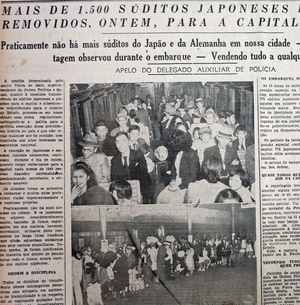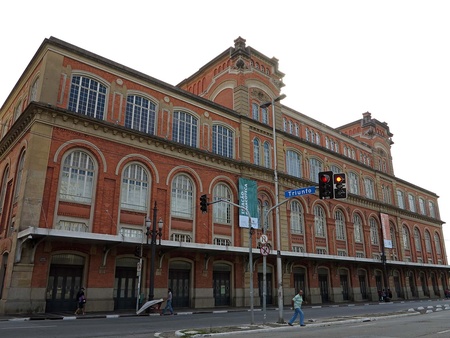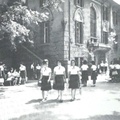What is "dangerous content"?
So what kind of "dangerous content" about wartime was written in "Senya"? The overall tone of the book is lyrical and highly praiseful of Japan, giving it the victorious atmosphere.
The headings of Chapter 1, Section 1 of "Senya" are "The Severance of Diplomatic Relations between Japan and Brazil," "The Struggles Under Funding Freeze," "The Difficulties of Japanese Language Education," "50 Japanese Farm Families Ordered to Leave," and "Japanese in the City Ordered to Leave," taking up 13 pages. Section 2, "Nostalgic Conde Street," is a nine-page explanation. Section 3, "Eviction Order for 4,000 Compatriots in the Coastal Area," lyrically describes the tragedy of Santos' forced eviction for eight pages.
The forced eviction of Santos took place on July 8, 1943. In the beginning of that month, two 10,000-ton American steamships and three 6,000-ton Brazilian steamships were sunk by a German submarine off the coast of Santos port. According to the local newspaper Tribuna de Santos, 6,500 Japanese immigrants were forcibly evicted within 24 hours, while around 500 German and Italian immigrants were somehow excluded...
"Abandoning everything, including their homes, goods, and belongings, and like a flock of sheep being chased, the women were barely clothed in clothing, carrying only small belongings, the cries of children, the groans of the elderly, and the shouts of soldiers. The endless, snaking procession was dragged toward the railroad tracks, where they were loaded onto trains like cargo, securely locked, and taken to the immigrant detention center in São Paulo" (Senya, p. 27).
There are few other examples in Brazilian history of such targeted persecution of a specific ethnic group, and those who suffered this tragic fate likely retained a sense of resentment towards the government for the rest of their lives.
Koichi Kishimoto likened the forced eviction of Santos to "Our 'Exodus from Egypt' in Greater South America" (ibid., p. 42). For Christians like Kishimoto, it was a major event comparable to the history of the suffering of the Jewish people when they escaped from Egypt under the guidance of Moses. The Jews recorded this event in the "Old Testament" so that it would not be forgotten even after thousands of years.
A similar idea was shared by documentary journalist Ueno Hidenobu (1923-1987), who portrayed Japanese society from the perspective of lower-class workers. He titled his reportage, published in 1977, "De Nipponki" (Record of a Journey Through Japan), which followed coal miners and their families who had lost their jobs after the coal mines in Kyushu were closed and they fled to Brazil and other countries in order to survive.
Kishimoto wrote a book about Japanese immigrants' version of the Exodus, thinking that he had to pass it on to future generations. However, looking at it from the present, it is clear that the historical facts have been completely excluded from the official history. In "70 Years of Immigration," the eviction of Santos is given only four lines.
Fear of the government distorted the official history
After the war, the first official history compiled by an organization representing the Japanese community, "A 70-Year History of Japanese Immigrants to Brazil" (1980, Editorial Committee, Chairman Saito Hiroshi), omitted most from the wartime period. The compilation was done during the military government, and any statements that could be criticized by the government were taboo. There is no mention of the fact that many Japanese community leaders were imprisoned during the war, as Kishimoto wrote in "Senya."
After the war, leaders in the Japanese community avoided recording wartime history, but Kishimoto challenged this taboo immediately after the war ended.
Takuji Fujii, who was involved in the founding of the São Paulo Shimbun, served as secretary-general of the Cultural Association and chairman of the prefectural federation, and is said to have been well aware of the dark side of the colony, wrote, "The biggest flaw in Japanese-language newspapers is that they are not permitted to criticize Brazilian politics. Miura Nippaku came into conflict with the Jiji Press over his criticism of Japanese local authorities, and was caught in the trap of criticizing Brazilian politics and suffered the hardship of being deported twice" (Prefectural Federation, 60 Years Since the Kasato Maru, p. 51).
"Miura Nippaku" refers to Miura Saku, the owner of the Nippaku Shimbun newspaper, who was issued with an exile order three times by President Vargas before the war, and this incident is known as the "pen-bashing incident."
The bitter experience of the expulsion of Miura Saku before the war, as well as the strengthening of restrictions on foreign language media and forced closures under the new Vargas national regime, was not forgotten. After the war, foreign language radio broadcasts were also banned by the military government. The fact that criticism of the Brazilian government was taboo cast a dark shadow over the entire Japanese language media world.
Saito Hiroshi, who served as editor-in-chief of the Paulista Newspaper and chairman of the editorial committee for the "70 Year History," explained the attitude of Japanese newspapers in 1968 as follows: "Discussing the political situation and policies of this country involves extremely delicate issues, so it is difficult for Japanese newspapers to move beyond the position of 'bystander.' There are precedents for this kind of literary scandal" (Radio Santo Amaro Annual Report, "Broadcasting," p. 31).
In Japan, "freedom of expression" refers to the content of the message, but in the Japanese immigrant community in the Allied powers, the language itself was an issue. Japanese language newspapers were destined to continue to drift between the strong nationalisms of the two countries.
10 years of criminal trial and victory
He was acquitted by the Central Trial Court of the State of São Paulo in March 1950, and then by the Central Federal Trial Court in October 1953. He then suffered for a total of 10 years, with another acquittal by the Supreme Court in 1957.
According to the court documents, Kishimoto's upstanding attitude towards life as a naturalized Brazilian, his status as the father of six Brazilian children, and his upstanding Christian character were recognized. The court also ultimately recognized that "contrary to the allegation that the book was a disturbance to national security, the book is an experiential history book about Japanese immigrants in São Paulo," and pointed out that "serious flaws were found in the police translation," and "the verdict is not guilty."
In other words, the federal court found that the police had deliberately mistranslated the message to create the image of a "national threat."
Books recognized as representative examples of human rights violations
In 2008, to celebrate the 100th anniversary of Japanese immigration, the copy of Senya, which had been confiscated by DOPS, was exhibited at the Resistance Memorial in São Paulo as part of the "Winning and Losing Struggle" exhibition. The fact that it was exhibited at the facility, which aims to educate citizens so that the human rights violations by the military regime are not repeated, was a recognition of the book as part of Brazilian history.
Writings about the struggle to win or lose generally portray the "winners" as "fanatics who refuse to accept that Japan lost the war" or "crazy people." A typical example of this is "Kyoshin" (Kyoshin, by Toshiro Takagi, 1970, published by the Asahi Shimbun).
The very belittling of the concept of "winning" and "losing" is a cognitive view of history, and originally it was a diagram of a nationalistic conflict between "fear of the Brazilian government" and "loyalty to the homeland."
As a result, some of the losers were excessively derogatory towards Japan and the Imperial Family, while some of the winners were excessively critical of Brazilians.
The claims of the winners included the assumption that "the Brazilian government, which unjustly oppressed Japanese immigrants before and during the war, would be punished when the Japanese army eventually landed," and their words, as exemplified in "Senya," always had a critical perspective on the government.
The prewar Japanese community leaders were discouraged by the freezing of their assets, torture, and imprisonment during the war. Having experienced persecution by the government during the war, the prewar Japanese community leaders, traumatized by this experience, turned to the side of suppressing the "kachigumi," and tried to suppress criticism of the government by leaving the "kachigumi" in history as a fanatic group.
At a time when criticism of the government was taboo even in Brazil's major mainstream media, Kishimoto wrote about it head-on in Japanese. Because he honestly described wartime events, including criticism, it became a best-seller in Colonia, but the price of being looked down upon by the government was enormous.
Now, 70 years after the end of the war, we can say that Kishimoto was an indomitable journalist who did not give up psychologically despite the persecution he suffered during the war, but rather used that experience as a springboard to maintain his fighting spirit.
© 2015 Masayuki Fukasawa







